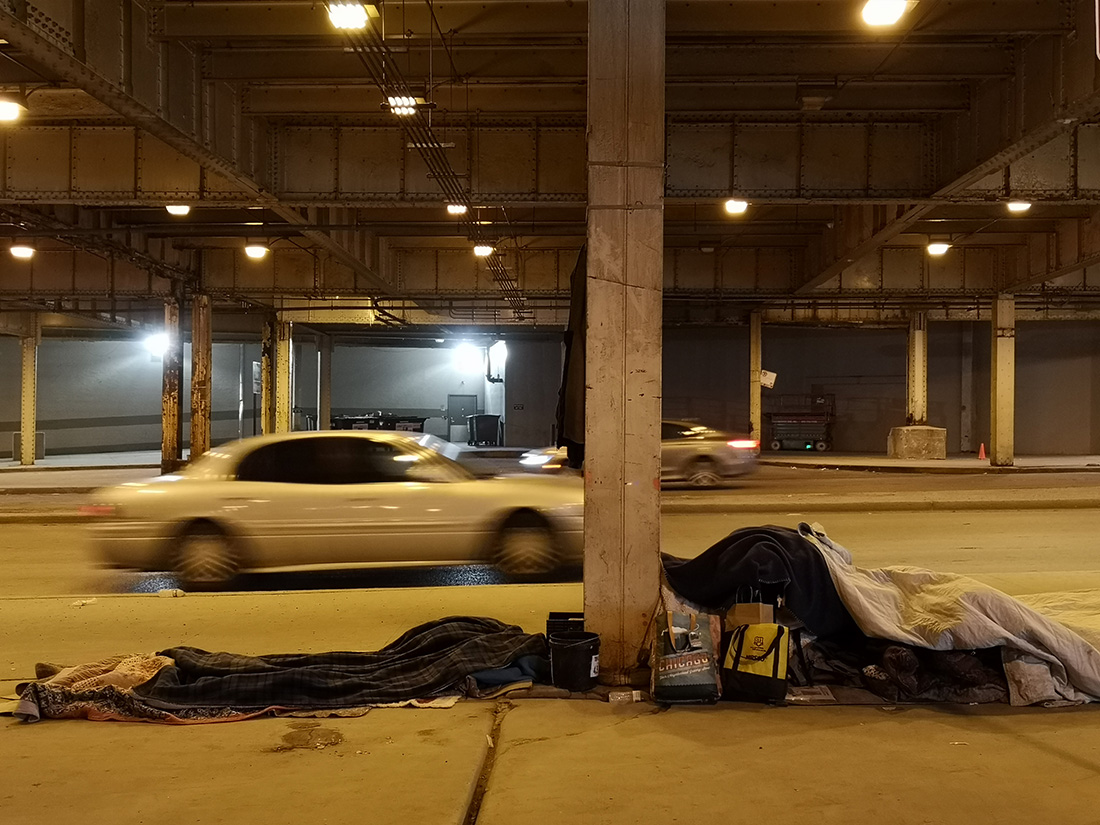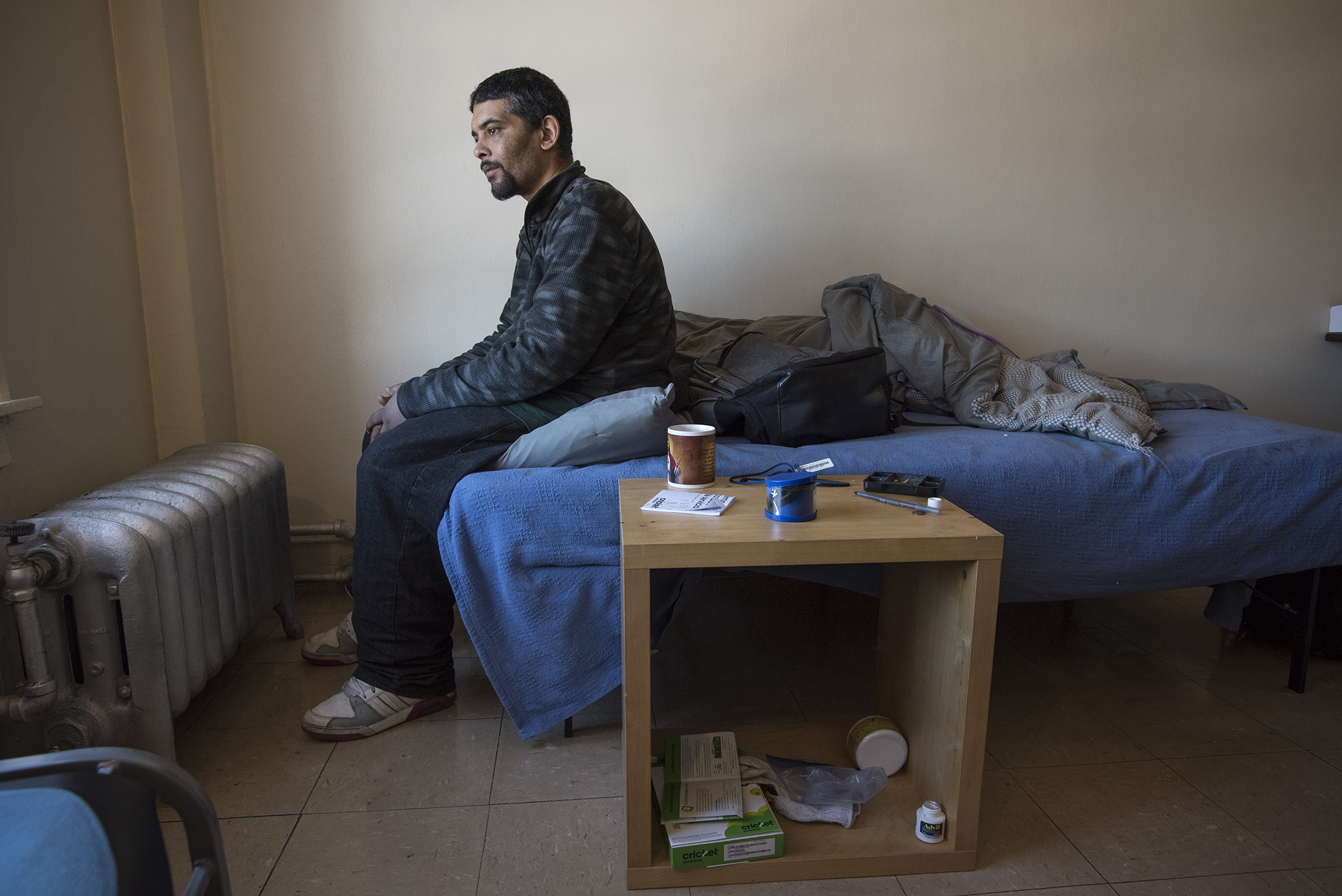By Lu Zhao
Medill Reports
When Ryan Ali looks back on his teenage years, he wishes he had been “the biggest nerd in the school.” He wasn’t. He was easily influenced by what he calls “peer pressure.”
There was a party night back in high school in Chicago. A friend called Ali into the bathroom. He opened some foil with white powder inside and chopped it up with a card. He gave Ali one-third of it.
“No, I’m cool,” Ali said.
“Come on, bro! Just a little bit,” his friend encouraged him. “It makes you feel good, man. Just one time.”
He made it sound like a treasure, “a million dollars.” Ali couldn’t resist any longer.
An “unbelievable” feeling spread across his body. Relaxing, good, full of love … Ali felt everything. That was the start of his 24-year addiction to heroin. He didn’t want to stop and didn’t truly stop until a few short months ago. Ali is tired of being trapped in addiction, he said. He is ready to turn his life around.
Ryan Ali talks about turning his life around after years of addiction. (Lu Zhao/Medill)
The number of heroin addicts in the United States is increasing. Nearly 494,000 people (12-years old or older) reported using heroin in the past year, according to the 2017 National Survey on Drug Use and Health.
I’VE GIVEN EVERYTHING TO DRUGS
I met Ali last November. He moved at a slow pace, sometimes stumbling due to his swollen legs. He also spoke slowly, like the slow-motion effect in a film, and he easily fell asleep. I thought he must be really tired. But in truth, he was high.
Ali, 43, tried to stop heroin multiple times. He once managed to stop for two years in his late 20s but then got the “bright idea,” and ended up hooked again.
“Just use it one more time,” Ali said to himself at that time. “Nobody would notice. [And] I won’t worry about it anymore.”
That was not the case. The physical sickness of withdrawal often drives a person to chase the ghost – the craving for drugs may never go away.
“You might sweat, your stomach hurts, your muscles ache and your nose runs,” Ali said, describing withdrawal symptoms as catching the flu but much worse.
Though the process of detoxification cannot kill you, many say they wish it would. The torture of it constantly and subliminally drives you back.
Relapse is a common feature of recovery from drugs, said Britt Borden, addiction specialist at Dragonfly Recovery in Chicago. About nine out of 10 opioid users reported a relapse after an inpatient addiction treatment program, a study shows. The trigger varies from person to person but shares a similar trend.
Joshua Smith, co-founder of Chicago Street Medicine and a medical student at UIC, explained the addiction by using a bio-psychosocial-spiritual model. The physical need for drugs is only the biological part of the problem, said Smith, whose organization, operated by UIC medical students and residents, gives care to the homeless.
Socially, Smith said, you are more likely to use drugs when you are constantly surrounded by substance-users.
This is especially true for Ali. With other “dope fiends” around, he didn’t stop shooting up for even one day in the past 10 years, he said.
As soon as his feet hit the floor each morning, Ali recalled, he would check his pocket to ensure he had enough drugs or money to buy them.
“Selfish. Selfish. Being selfish,” he repeated. “It was automatic, I just did it.”
Ali used to have a home. In a six-year relationship, Ali had two sons with his ex-girlfriend. But he didn’t pay any attention to them.
“When you use drugs, you don’t think about girls,” Ali said. “All I wanted was dope.”
One day when he got back home at night, he only saw emptiness. Ali felt a bad vibe – he sensed his ex-girlfriend might have left. He slept in his jacket and shoes, waiting for her return. She didn’t come back. Ali left the house the next morning without going back.
Years later, Ali ran into his sons with their aunt and grandmother, who are all in Texas now.
“It bothers me a lot that I can’t be with them,” said Ali, though he doesn’t want to talk much about his sons who just reached adulthood. Ali was only with them the first two years of their lives. “I watch them grow up on social media.”
Ali also found he couldn’t work because of drugs.
Ali has done different types of jobs, including construction, carpentry and food preparation. Yet work alone couldn’t support his addiction. There are other ways of making money.
Robbery has put Ali in jail four times, he said. He stole from convenience stores and spent about six years in prison in total.
“I’ve given up everything for heroin,” he said. “It completely destroyed me.”
A robbery in 2002 meant three years of incarceration – the longest stint in prison. Ali robbed a 7-Eleven with two partners. He drove and pulled the car over in the alley behind the store.
“Open this register up!” they yelled at the clerk, holding him at gunpoint. “Give me all the money and don’t move!”
“I’m not playing with you,” Ali said he threatened the clerk, demanding he open the safe.
Ali took out a stopwatch, he remembered, saying, “We got one minute.” Two minutes and 15 seconds later, they left with $6,000.
DRUGS MIGHT KILL ME
Substance abuse often leads to homelessness, according to the National Coalition for the Homeless 2017 report. A 2003 report estimates that 38 percent of homeless people were dependent on alcohol and 26 percent abused other drugs.
Ali became homeless 12 years ago. He started working on the street – panhandling and hustling.
If you have ever walked on Michigan Avenue, you probably noticed people spread along the sidewalks hustling or panhandling. Often, they stay at the same place, quietly holding a sign and a bottle.
Ali used to be one of them. Not having good rest and keeping injecting in the same area, Ali got an infection on his legs six years ago. He didn’t go to the hospital until the small abscess turned into an open laceration with a bone infection. Now both of his legs look like tree trunks – swollen and dark. He has been to the emergency room 13 times.

Showing the brutal wounds on his legs, he could sometimes earn more than $100 a day, he said. Often, he spent all his money on drugs.
“I was willing to die for drugs,” said Ali, who used to shoot up as much heroin as much as possible. He once used 22 bags of heroin a day, he said.
Ali is tired now.
Being addicted for so many years, he realized the wounds, as well as the heroin, might kill him.
“I want to live,” Ali said. “I don’t wanna die being addicted. I would rather die being clean.”
In addition to wounds, long-term heroin addiction use can cause other health problems. For example, it can change the physical structure and physiology of the brain, according to the National Institute on Drug Abuse. After receiving heroin, the body requires more and more heroin to achieve the same effects, which might result in drug overdoses, and even worse, death.
Heroin-related overdose deaths in the United States increased almost seven-fold from 1999 to 2017, a report from the National Center for Health Statistics shows. During 2017, over 15,000 people died from drug overdoses involving heroin. Some of them were Ali’s friends or family members.
“I’ve watched so many people die,” he said. “Death hurts me.”
Ali finally went to the hospital last November. Though his legs were not amputated, he has to take care of them and will probably need one year to heal, his doctor said.
So housing was an urgent need. His legs need rest. When he was in the hospital, Ali was lucky to be one of the last ones enrolled in the Better Health through Housing program, which was launched by the University of Illinois Hospital & Health Sciences System (UI Health) to improve health conditions for patients with chronic health problems.
It took Ali two months to get temporary housing in an SRO unit in Uptown. The two months were his “worst time,” Ali said. Still feeling the pain from his legs, he had nowhere to get rest. He used to live on Lower Wacker Drive, but it was too chilly in the winter. Spending most nights on the train, Ali couldn’t get good sleep by getting on and off several times a night. He was eager for a home.

INTO THE BRIGHT
Ali is determined to stop heroin, which he knows is the only way to really heal himself. He was started on methadone in the hospital and transitioned to an outpatient methadone clinic. The doctor prescribed 45-milligrams of methadone for him daily, which turned out to be too much.
“I was as high as a kite,” said Ali, imitating what he looked like at that time. “[You] throw anything in the house at me and I won’t wake up.”

Now he is on 40 milligrams and plans to decrease one milligram every week.
Methadone is one of the dominant medications used to treat heroin addiction, and it has been used since the 1950s. Yet its unpredictable half-life, the time it takes half of a medication to be eliminated from the bloodstream, concerns many doctors, Smith said.
“[The half-life is] depending on physiology, the way your liver detoxifies opioids,” Smith said. “That makes it very difficult to get patients to where they need to be, to get to the right dose [of methadone].”
Hopefully, Smith said, Ali might be completely off opioids by Christmas of 2019. For Ali, being healthy means not being on methadone, Smith said.
Going to a methadone clinic every morning, attending anonymous meetings twice a month, looking for an apartment, applying for social security benefits … Ali stays on track with a busy life.
“I’m very proud of him [that] he’s getting stuff together,” said Michael Krapf, who is also on methadone treatment and has known Ali for eight months. “Ali has a great heart … if he is your friend he will give you a shirt off his back.”
Ali spends almost all his time staying at home when he doesn’t have appointments. Though his legs are still swollen, they’re turning pink and healing.
Ali went to see the doctor last month. “My doctor couldn’t believe it,” he said, noting the doctor said his legs looked “100 percent better.”
Everyone familiar with Ali calls him smart. Being addicted for 24 years, Ali got his own expertise. He can identify drug addicts by just looking at them, Ali said. He wants to be a drug counselor.
“I want to help people,” he said, to “prevent them from going through this.”

